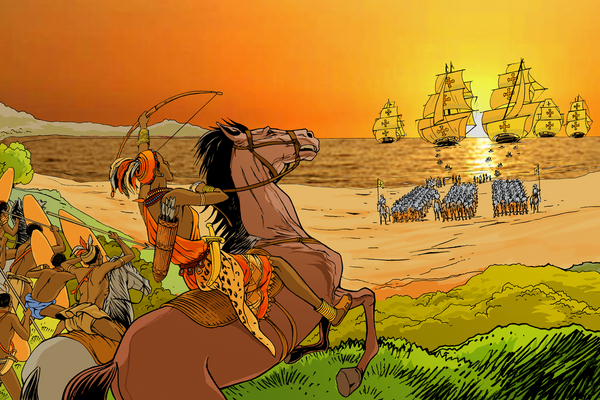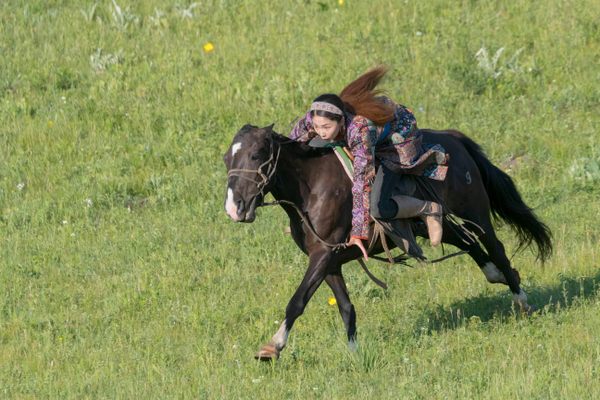The Female Space Sculptor Who Designed the Earliest Space and Aviation Helmets
Alice King Chatham’s name is attached to some of the world’s most pivotal aviation and space experiments.

Who is the real Alice King Chatham, sculptor of helmets worn by monkey astronauts?
That was the question posed to a panel of four celebrities—one of whom was Betty White—in the August 31, 1964 episode of the game show To Tell The Truth. The host, Bud Collyer, presented three people to the panel, all of whom claimed to be King Chatham.
As you can see at the 18-minute mark in the video below, the celebrities interrogated the women with questions. Two were impostors, their answers all lies. One was the real King Chatham—a sculptor who helped craft the earliest space helmets of the United States Space Program.
“I have cast in wax the heads of the seven Mercury astronauts,” the host Bud Collyer read from a statement King Chatham wrote, before the panel spoke to the women. “These models were used to design for each man a perfect fitting helmet liner.”
None of the celebrities were able to correctly identify King Chatham, whose exact contributions to the field of space helmet design are the subject of debate.
During the height of 1960s space and flight exploration in the United States, Alice King Chatham worked behind the scenes creating partial-pressure pilot suits, test dummies, oxygen masks, space beds, and helmets for NASA and the U.S. Air Force. She even helped design suits for the television show Star Trek.
In the early 1940s, King Chatham was working as an artist and sculptor when she was recruited by the Air Force to help make the first successful oxygen breathing masks worn by all American World War II pilots. She was involved in an array of major experiments, studies, and projects, from creating space helmets for the 1963 first man-in-space program Project Mercury to designing prototype suits for monkeys that flew in the Aerobee sub-orbital rocket tests during the 1940s.

It was not uncommon for female artists to be recruited into the U.S. Army for their skills during wartime. Around 1943, King Chatham had been sculpting ducks, dogs, and horses at the Art Institute in Dayton, Ohio, when she received a request from the head of the anthropology unit at Wright Field’s Aero-Medical Laboratory, Francis Randall. “As an artist and sculptress she understood the human body,” reported Lee Street for The Baltimore Sun in 1953.
In the ’40s, new fighter planes were reaching increasingly higher altitudes, requiring pilots to wear pressurized masks to avoid blacking out during flight. King Chatham’s sculpting expertise was needed at the Wright Air Development Center, the Air Force base near Dayton, for a crucial mission: to help perfect an oral-nasal oxygen mask for pilots traveling above 20,000 feet. The various designs and prototypes eventually led to the mask that became ubiquitous head gear among World War II pilots.
King Chatham became an expert of the flight helmet and the lab’s equipment specialist for personal protective gear. She is credited with developing a new pressure helmet that improved an iteration of the 1946 S-1 pressure flight suits, and special ear counter-pressure devices.
Scientists came to King Chatham with a list of different criteria for different kinds of helmets—one with a breathing tube, a microphone, and an opening for liquid feeding. She would, over several months, fashion experimental models out of rubber, plastics, and fabrics.
“The professional men at the Laboratory admit they don’t know how she does it,” Street wrote.

King Chatham’s lab often smelled like a zoo, says Street. She fitted oxygen equipment to many animals that flew in tests, including guinea pigs, rabbits, pigs, and a 140-pound Saint Bernard. King Chatham also made clothes for monkeys, outfitting them in tiny pressure suits and helmets for the Aerobee rockets that flew 34 miles above the Earth. However, one accomplishment under high debate and speculation is her involvement with the X-1 project, the top-secret rocket plane piloted by Captain Chuck Yeager that would break the sound barrier in 1947.
According to her obituary and authors of the book Mothers of Invention, King Chatham had to create a special helmet that would protect Yeager from the extreme pressures of the high-speed flight. It’s said that she had tested several different prototypes, which led to the actual helmet Yeager wore during the X-1 mission. However, research by Shayler David and Ian Moule in Women in Space contradicts her ownership of the helmet’s design. Yeager stated that he had built it himself by cutting a World War II tank helmet and fastening it to a leather flying helmet. King Chatham may have been a part of designing pressure helmets of Yeager’s later X-1 missions.

Her work designing oxygen masks and pilot helmets for the Air Force led her to NASA. For the Mercury Project, she was commissioned to create the helmets, casting each of the astronauts’ heads in wax to get perfect, custom headgear. “All the astronauts are extremely stable, and have great personalities,” King Chatham told Mary Ann Callan for the Los Angeles Times in 1961. “They were easy to work with, even though the fitting took half a day each.”
King Chatham would often be the lone woman assigned to projects. During her employment at Douglas Aircraft Company in Santa Monica, California in the 1960s, she was the only female developing features to add comfort in personnel gear, wrote Callan. She had the unprecedented task of thinking “of everything, because there is simply no ‘room service’ in a space capsule.”

While the exact details of her contributions to space and aviation innovation remains unknown, it’s clear that King Chatham’s career as a space sculptor was captivating, indicated by the amazed cast of To Tell The Truth.
King Chatham died in Los Angeles at 81 in July 1989. A number of her early art sculptures were placed on display at the Dayton Art Institute, according to her obituary.
“What Alice did exactly is currently debatable,” Bruce Hess, historian at Wright-Patterson Air Force Base says in Women in Space, “but she undoubtedly was involved in those pioneering steps involving manned space exploration and flight.”






















Follow us on Twitter to get the latest on the world's hidden wonders.
Like us on Facebook to get the latest on the world's hidden wonders.
Follow us on Twitter Like us on Facebook